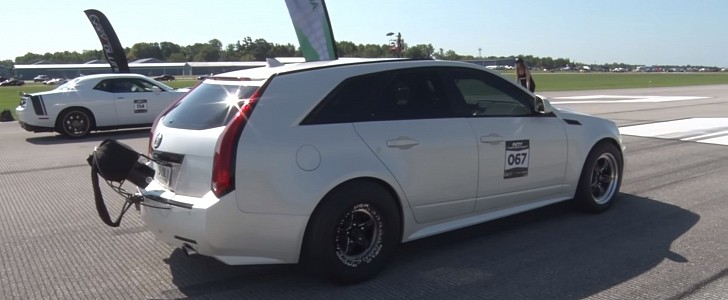Cadillac used to make wagons, but after the CTS-V Sport Wagon, the family-friendly body went out of style as more and more people transitioned to crossovers and sport utility vehicles. Be that as it may, the go-faster longroof is nothing to scoff at.
When they were new, the CTS-V sedan as well as the station wagon had 556 horsepower and tons of torque on tap thanks to the LSA supercharged small-block V8. Magnetic Ride Control and Brembo brakes helped them both handle like a dream, and better still, customers were treated to a six-speed stick shift like the transmission in this particular car.
The “world’s first 200-mph CTS-V Wagon” is far from stock, though. The owner says that his pride and joy is more powerful than the dyno on which it has been tested, and the additional suck-squeeze-bang-blow comes courtesy of a 106-millimeter snail located out back. The turbocharger is fed by an inlet in the driver-side quarter window, and at the crankshaft, the turbo-only land missile develops 1,700 horsepower.
However, the path to 200 miles per hour in a family car wasn’t as easy as the owner thought it would be. 164.23 mph (264.3 kph) is all the Caddy had to offer on the first half-mile pass against a Dodge Challenger. The second day, which was a little colder, the CTS-V Sport Wagon did break the barrier by clocking 200.26 miles per hour or 322.28 kilometers per hour.
What comes as a bit of a surprise about this car is that the rear seats and seat belts are still there despite the meaty drag radials, no-nonsense roll cage, and uncomfortable bucket seats up front. The gaping exhaust pipe in the middle of the rear bumper needs no explanation given the turbocharger’s location and how a rear-mounted turbo works. As for what happened to the stock 1.9-liter supercharger and the 2.3-liter Maggie the owner ran until recently, both of them are out in favor of a hotter cam and new intake.
The finishing touch? That would be the parachute that obscures the rear plate, a must-have for any 200-mph strip slayer.
The “world’s first 200-mph CTS-V Wagon” is far from stock, though. The owner says that his pride and joy is more powerful than the dyno on which it has been tested, and the additional suck-squeeze-bang-blow comes courtesy of a 106-millimeter snail located out back. The turbocharger is fed by an inlet in the driver-side quarter window, and at the crankshaft, the turbo-only land missile develops 1,700 horsepower.
However, the path to 200 miles per hour in a family car wasn’t as easy as the owner thought it would be. 164.23 mph (264.3 kph) is all the Caddy had to offer on the first half-mile pass against a Dodge Challenger. The second day, which was a little colder, the CTS-V Sport Wagon did break the barrier by clocking 200.26 miles per hour or 322.28 kilometers per hour.
What comes as a bit of a surprise about this car is that the rear seats and seat belts are still there despite the meaty drag radials, no-nonsense roll cage, and uncomfortable bucket seats up front. The gaping exhaust pipe in the middle of the rear bumper needs no explanation given the turbocharger’s location and how a rear-mounted turbo works. As for what happened to the stock 1.9-liter supercharger and the 2.3-liter Maggie the owner ran until recently, both of them are out in favor of a hotter cam and new intake.
The finishing touch? That would be the parachute that obscures the rear plate, a must-have for any 200-mph strip slayer.







